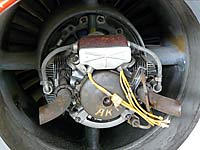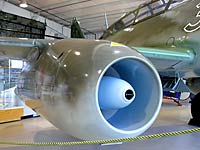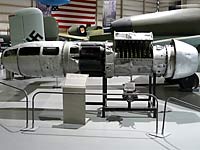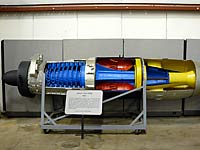| page 1 of 2 |
| US Air Force Museum - WWII - Messerschmitt Me-262 Swallow
Bill Maloney 1/20/2007 |
| page 1 of 2 |
Three other Junkers Jumo 004B Turbojets and another WWII Messerschmitt Me-262 German Jet at other Aviation Museums in the Northeast |
|
 |
 |
| Junkers Jumo 004B with exposed Reidel 2 cycle starter motor at the Air Victory Museum in Lumberton, NJ | Messerschmitt Me-262 at the Delaware Valley Historical Aviation Association in Willow Grove, PA |
 |
 |
| Another Junkers Jumo 004B Turbojet Engine at the Wings Of Eagles Museum in Horseheads, NY | Junkers Jumo 004B Turbojet cutaway at the New England Air Museum in Hartford, CT |
Length: 34 feet, 9 inches
Wingspan: 41 feet
Height: 12 feet, 6 inches
Crew: 1
Weight: Empty - 9,742lbs Takeoff - 15,720lbs
Max Speed: 540mph at 19,685 feet
Cruise Speed: N/A
Range: 652 miles
Service Ceiling: N/A
Fuel Capacity: 679 gallons internally
Powerplant: Two Junkers 004B Orkan turbojet engines 1,984lbs thrust each
Armament:
Four 30mm MK-108 cannon, 100 rounds for each upper gun, 80 rounds for each lower gun - all nose mounted
First Flight : July 18, 1942
The Messerschmitt Me 262 Swallow (or Stormbird) has got to be one of the hottest looking aircraft ever designed. That shark-like fuselage not only looks menacing, it's also an aerodynamically well designed lifting body. Fortunately due to lack of high temperature resistant alloys and quality control problems arising from the Nazi's use of slave labor, the Me 262 had a lot of mechanical problems. Its Junkers Jumo 004 Turbojet engine had a time between overhaul interval of less than 50 hours. Mostly this was due to the wartime shortage of nickel alloys which would have enabled them to manufacture turbine blades that were more heat resistant. The materials used were not much better than common steel and were prone to stretching and cracking. In today's turbine aviation engines if you lose a compressor blade it might take out one or more blades behind it and keep running, although with a good deal of vibration and lessened power. If a Junkers Jumo 004 turbojet lost a compressor blade, it almost invariably led to a catastrophic cascading failure with the turbine shedding more and more blades in a domino effect until the engine literally blew apart. Interestingly enough the Arado 234 bomber which used the same engines had much fewer problems. The difference with the Arado 234 was that after takeoff the throttles were set to a cruise position and generally left there until landing. This made for less variations in operating temperatures and RPMs resulting in fewer compressor blade cracks and failures.
When the Junkers Jumo 004 turbojets were operating properly they were unbeatable and uncatchable. They were most vulnerable at takeoff and landing. The Me 262 did not have the complicated fuel management that today's gas turbine engines have. If the pilot advanced or retarded the throttles too quickly he risked over or underfuelling the engine causing a flame out and total power loss. The engines were also sensitive to angle of attack changes. If the airflow deviated much from coming straight into the intake, such as in abrupt maneuvering, the airflow could be disturbed enough stall the compressor, flaming out the engine.